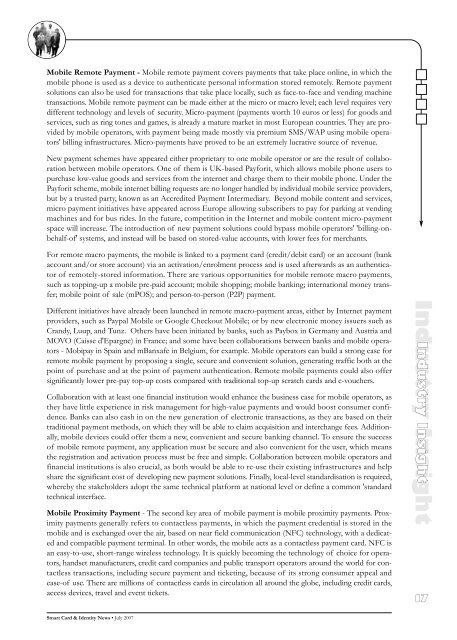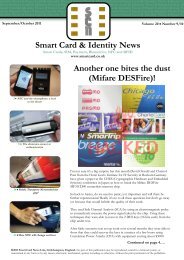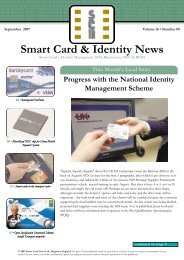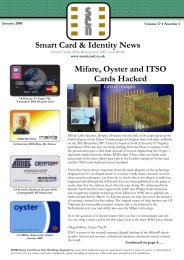Smart Card Identity News - Smart Card News
Smart Card Identity News - Smart Card News
Smart Card Identity News - Smart Card News
Create successful ePaper yourself
Turn your PDF publications into a flip-book with our unique Google optimized e-Paper software.
Mobile Remote Payment - Mobile remote payment covers payments that take place online, in which the<br />
mobile phone is used as a device to authenticate personal information stored remotely. Remote payment<br />
solutions can also be used for transactions that take place locally, such as face-to-face and vending machine<br />
transactions. Mobile remote payment can be made either at the micro or macro level; each level requires very<br />
different technology and levels of security. Micro-payment (payments worth 10 euros or less) for goods and<br />
services, such as ring tones and games, is already a mature market in most European countries. They are provided<br />
by mobile operators, with payment being made mostly via premium SMS/WAP using mobile operators'<br />
billing infrastructures. Micro-payments have proved to be an extremely lucrative source of revenue.<br />
New payment schemes have appeared either proprietary to one mobile operator or are the result of collaboration<br />
between mobile operators. One of them is UK-based Payforit, which allows mobile phone users to<br />
purchase low-value goods and services from the internet and charge them to their mobile phone. Under the<br />
Payforit scheme, mobile internet billing requests are no longer handled by individual mobile service providers,<br />
but by a trusted party, known as an Accredited Payment Intermediary. Beyond mobile content and services,<br />
micro payment initiatives have appeared across Europe allowing subscribers to pay for parking at vending<br />
machines and for bus rides. In the future, competition in the Internet and mobile content micro-payment<br />
space will increase. The introduction of new payment solutions could bypass mobile operators' 'billing-onbehalf-of'<br />
systems, and instead will be based on stored-value accounts, with lower fees for merchants.<br />
For remote macro payments, the mobile is linked to a payment card (credit/debit card) or an account (bank<br />
account and/or store account) via an activation/enrolment process and is used afterwards as an authenticator<br />
of remotely-stored information. There are various opportunities for mobile remote macro payments,<br />
such as topping-up a mobile pre-paid account; mobile shopping; mobile banking; international money transfer;<br />
mobile point of sale (mPOS); and person-to-person (P2P) payment.<br />
Different initiatives have already been launched in remote macro-payment areas, either by Internet payment<br />
providers, such as Paypal Mobile or Google Checkout Mobile; or by new electronic money issuers such as<br />
Crandy, Luup, and Tunz. Others have been initiated by banks, such as Paybox in Germany and Austria and<br />
MOVO (Caisse d'Epargne) in France; and some have been collaborations between banks and mobile operators<br />
- Mobipay in Spain and mBanxafe in Belgium, for example. Mobile operators can build a strong case for<br />
remote mobile payment by proposing a single, secure and convenient solution, generating traffic both at the<br />
point of purchase and at the point of payment authentication. Remote mobile payments could also offer<br />
significantly lower pre-pay top-up costs compared with traditional top-up scratch cards and e-vouchers.<br />
Collaboration with at least one financial institution would enhance the business case for mobile operators, as<br />
they have little experience in risk management for high-value payments and would boost consumer confidence.<br />
Banks can also cash in on the new generation of electronic transactions, as they are based on their<br />
traditional payment methods, on which they will be able to claim acquisition and interchange fees. Additionally,<br />
mobile devices could offer them a new, convenient and secure banking channel. To ensure the success<br />
of mobile remote payment, any application must be secure and also convenient for the user, which means<br />
the registration and activation process must be free and simple. Collaboration between mobile operators and<br />
financial institutions is also crucial, as both would be able to re-use their existing infrastructures and help<br />
share the significant cost of developing new payment solutions. Finally, local-level standardisation is required,<br />
whereby the stakeholders adopt the same technical platform at national level or define a common 'standard<br />
technical interface.<br />
Mobile Proximity Payment - The second key area of mobile payment is mobile proximity payments. Proximity<br />
payments generally refers to contactless payments, in which the payment credential is stored in the<br />
mobile and is exchanged over the air, based on near field communication (NFC) technology, with a dedicated<br />
and compatible payment terminal. In other words, the mobile acts as a contactless payment card. NFC is<br />
an easy-to-use, short-range wireless technology. It is quickly becoming the technology of choice for operators,<br />
handset manufacturers, credit card companies and public transport operators around the world for contactless<br />
transactions, including secure payment and ticketing, because of its strong consumer appeal and<br />
ease-of use. There are millions of contactless cards in circulation all around the globe, including credit cards,<br />
access devices, travel and event tickets.<br />
Industry Insight<br />
17<br />
<strong>Smart</strong> <strong>Card</strong> & <strong>Identity</strong> <strong>News</strong> • July 2007
















